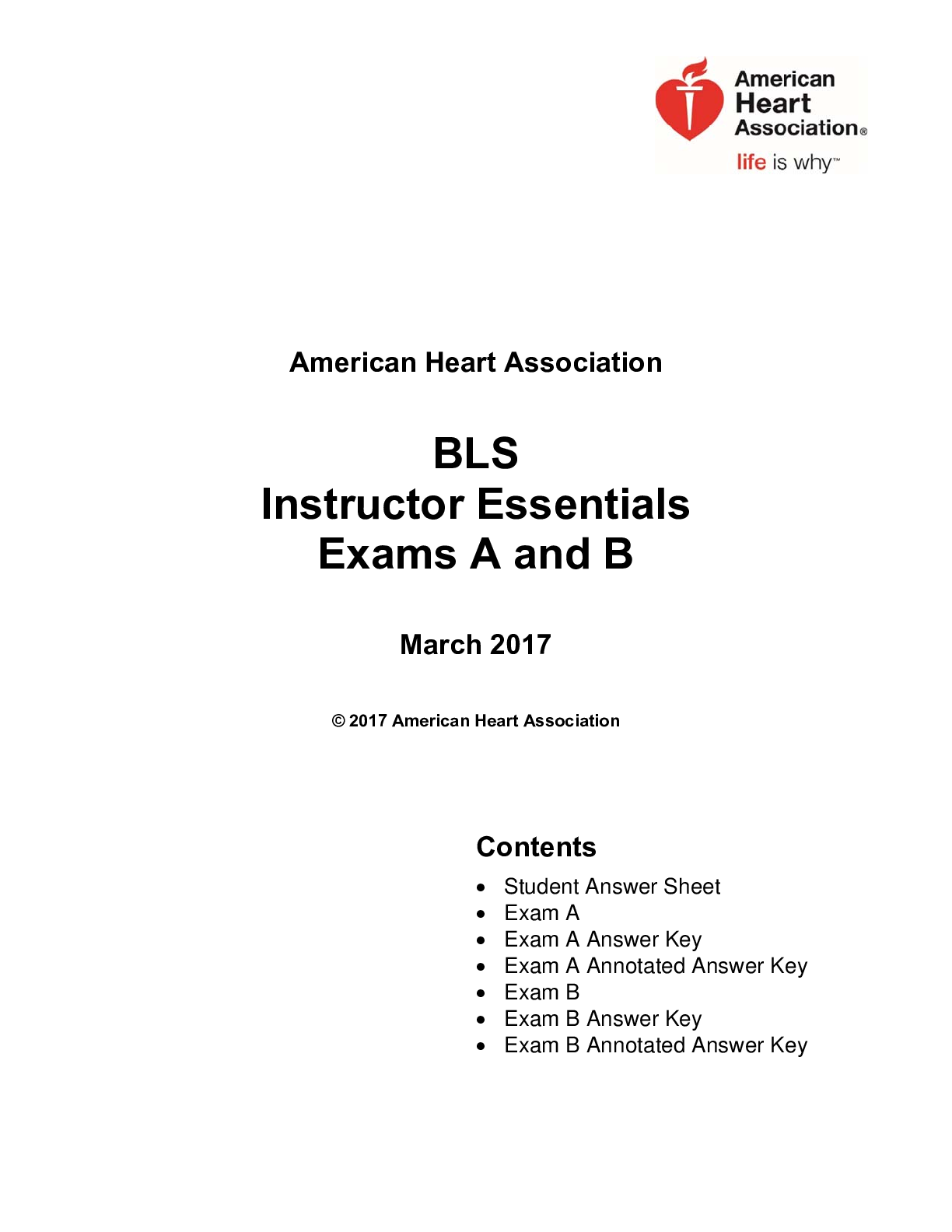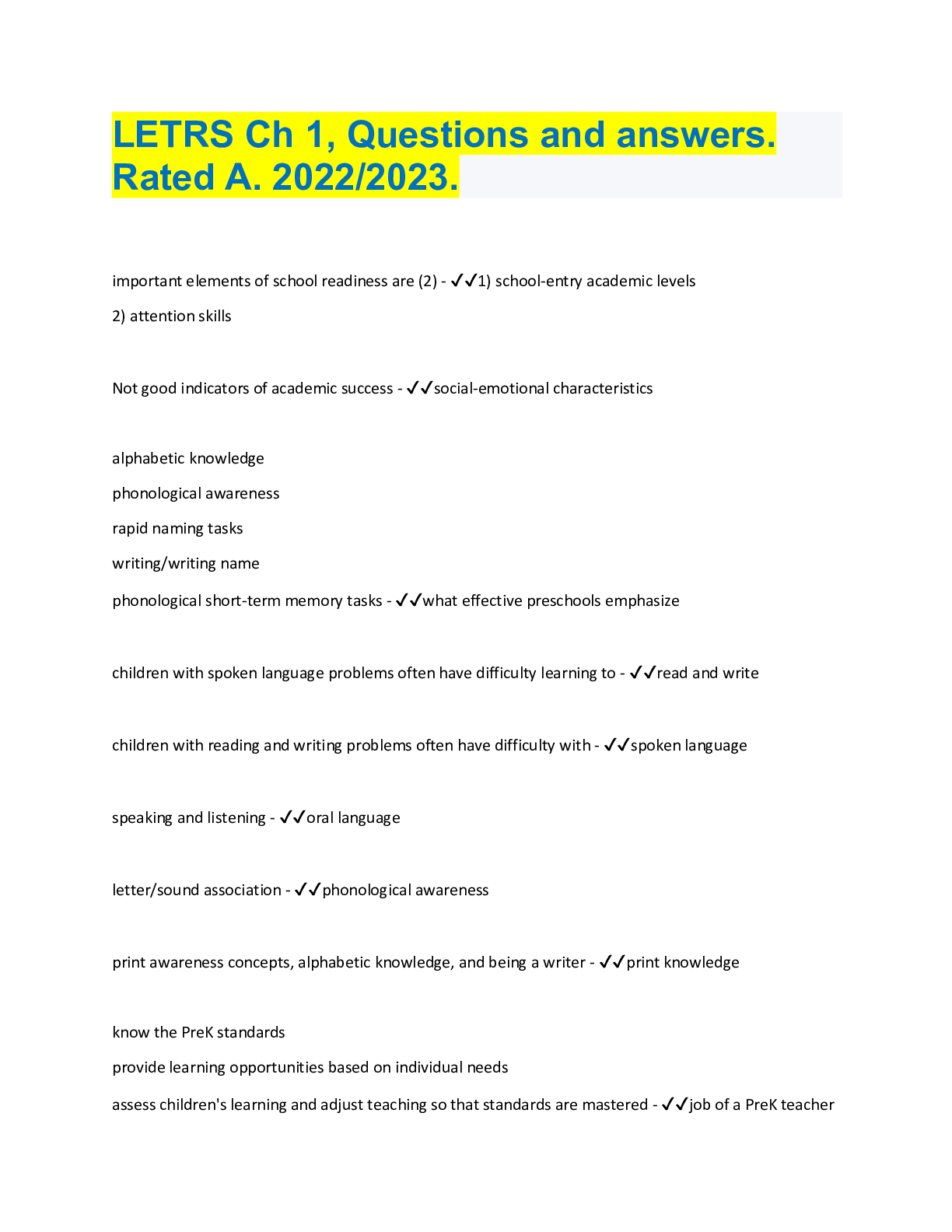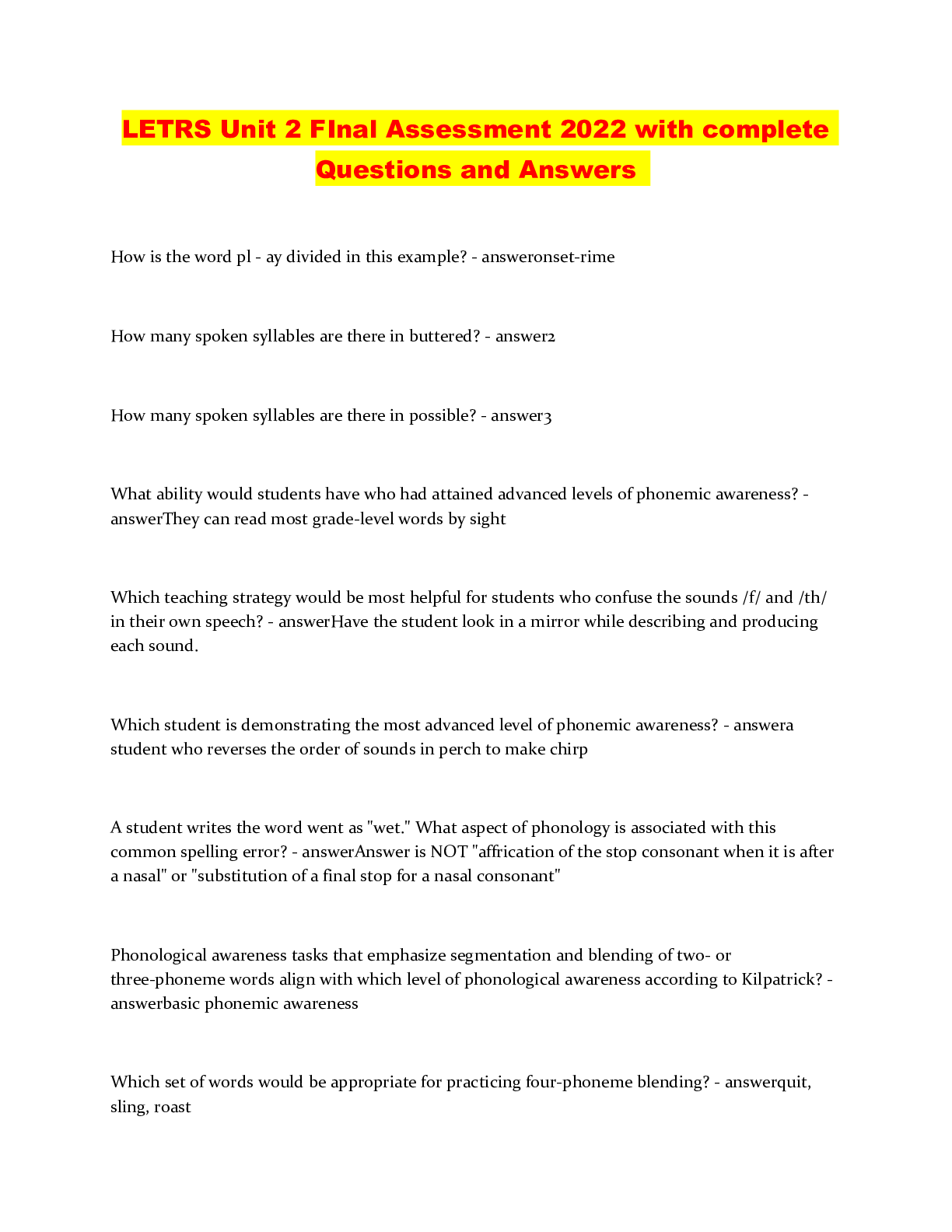Military Studies > QUESTIONS & ANSWERS > US ARMY SEJMPE 2 Test 1 - 17 Questions and Answers All Rated A+ (All)
US ARMY SEJMPE 2 Test 1 - 17 Questions and Answers All Rated A+
Document Content and Description Below
DIME -----Diplomatic, Informational, Military, and Economic The President, Secretary of Defense (SECDEF), and Chairman of the Joint Chiefs of Staff (CJCS) provide: -----national strategic gu... idance and direction for Combatant Commanders and Service Chiefs to ensure the national strategic objectives are clearly defined, understood, and achievable. The operational branch chain of command runs from: -----the President, through the SECDEF, to the Combatant Commanders for missions and forces assigned to their commands. Combatant Commanders -----exercise Combatant Command (COCOM) command authority over assigned forces. Sub-unified commanders and JTF commanders exercise: -----Operational Control (OPCON) of joint forces. administrative control (ADCON) -----Direction or exercise of authority over subordinate or other organizations in respect to administration and support. 7. Combatant command (CCMD) -----A unified or specified command with a broad continuing mission under a single commander established and so designated by the President, through the Secretary of Defense and with the advice and assistance of the Chairman of the Joint Chiefs of Staff. combatant commands: -----typically have geographic or functional responsibilities. Combatant Command (command authority) (COCOM). -----Non-transferable command authority, which cannot be delegated, of a combatant commander to perform those functions of command over assigned forces involving organizing and employing commands and forces. Command relationships are: -----The interrelated responsibilities between commanders, as well as the operational authority exercised by commanders in the chain of command; defined further as combatant command (command authority), operational control, tactical control, or support. Joint Force is: -----A general term applied to a force composed of significant elements, assigned or attached, of two or more Military Departments, operating under a single joint force commander. Joint Force Commander (JFC) -----A general term applied to a combatant commander, subunified commander, or joint task force commander authorized to exercise combatant command (command authority) or operational control over a joint force. Operational Control (OPCON) is: -----The authority to perform those functions of command over subordinate forces involving organizing and employing commands and forces, assigning tasks, designating objectives, and giving authoritative direction necessary to accomplish the mission. Support is: -----The action of a force that aids, protects, complements, or sustains another force in accordance with a directive requiring such action. Tactical Control (TACON) is: -----The authority over forces that is limited to the detailed direction and control of movements or maneuvers within the operational area necessary to accomplish missions or tasks assigned. Doctrine provides a military organization with a: -----common philosophy, a common language, a common purpose, and a unity of effort. - GEN George H. Decker, United States Army What is the purpose of joint doctrine? -----to enhance the operational effectiveness of U.S. forces. Joint doctrine is: -----authoritative guidance and will be followed except when, in the judgment of the commander, exceptional circumstances dictate otherwise. Joint doctrine is not dogmatic -----the focus is on how to think about operations, not what to think about operations. The judgment of the commander based upon the situation is always: -----paramount The joint force commander has the authority and responsibility to: -----tailor forces for the mission at hand, selecting those that most effectively and efficiently ensure success. The chief principle for employment of U.S. forces is to: -----ensure achievement of the national strategic objectives established by the President through decisive action while concluding operations on terms favorable to the United States. Joint operations doctrine is: -----built on a sound base of war fighting theory and practical experience. How many joint doctrine principles of war are there? -----nine principles of war have been consistent in joint doctrine with an additional three that may also apply to joint operations. An adversary using IW methods typically will -----endeavor to wage protracted conflicts in an attempt to break the will of their opponent and its population. IW manifests itself as one or a combination of several possible forms including: -----insurgency, subversion, terrorism, information operations (disinformation, propaganda, etc.), organized criminal activity (such as drug trafficking), strikes, and raids. unlike traditional war that focuses on the control of an adversary's: -----forces, territory, or control of populations. DIME instruments are leveraged to achieve national interests -----Freedom, Democracy and Free Enterprise. National power is: -----the capacity that a sovereign nation-state can leverage to achieve its national interests. The instruments of national power are: -----Diplomatic, Informational, Military and Economic (DIME) Diplomacy is: -----the principal instrument for engaging with other states and foreign groups to advance U.S. values, interests, and objectives. Which U.S. Government is the agency for foreign affairs? -----The Department of State Are geographic combatant commanders responsible for aligning military activities with diplomatic activities in their assigned areas of responsibility? -----Yes What entails focused efforts to create, strengthen, or preserve conditions favorable for the advancement of national interests, policies, and objectives by understanding and engaging key audiences through the use of coordinated programs, plans, themes, messages, and products synchronized with the actions of all instruments of national power. -----Commander's Communication Synchronization (CCS) What are the predominant military activities that support CCS? -----the information operations (IO), public affairs (PA), and defense support to public diplomacy (DSPD). Information Operations (IO) are -----those military actions to attack an adversary's decision making while protecting our own. Public Affairs (PA) are -----those public information, command information, and community engagement activities directed toward both the external and internal publics with interest in the DOD. Defense Support to Public Diplomacy (DSPD): -----comprises those activities and measures taken by DOD components to support and facilitate USG public diplomacy efforts. What is the President's role? -----National Security Strategy, and Unified Command Plan What is the Secretary of Defense role? -----Defense Strategic Guidance, and Guidance for Employment of the Force What is the Chairman of the Joint Chiefs of Staff's role? -----National Military Strategy, Joint Strategic Capabilities Plan, and Global Force Management Implementation Guide. The Combatant Commander's role? -----Strategic Estimate, Theatre Strategy, Theatre Campaign Plans, and Plans and others. The Chairman of the Joints Chief of Staff and the Combatant Command must maintain -----Continuous interaction and are unified action in execution. The SECDEF's guidance documents include: -----the Defense Strategic Guidance (DSG) and the Guidance for Employment of the Force (GEF). CJCS provides guidance in the -----National Military Strategy (NMS) and Joint Strategic Capabilities Plan (JSCP). The Chairman also issues the Global Force Management Implementation Guidance with the approval of the SECDEF. The UCP states that communications between the President or SECDEF and the Combatant Commanders shall be transmitted through the: -----CJCS, unless otherwise directed. When significant operations overlap AORs -----the UCP states that a task force will be formed. Command of the task force will be determined by the Secretary of Defense and assigned to the appropriate combatant commander. What outlines DOD's approach to implementing the President's National Security Strategy (NSS). -----Defense Strategic Guidance (DSG) Who also promulgates the Quadrennial Defense Review (QDR), a legislatively-mandated review of DOD strategy and priorities. -----The Secretary of Defense How often will the SECDEF conduct a comprehensive examination of the national defense strategy, force structure, forced modernization plans, infrastructure, budget plan, and other elements of the defense program and policies of the U.S? -----Every four years. How many QDRs have there been? -----Four, 1997, 2001, 2006, and 2010 The Defense Strategic Guidance is reviewed and published how often? -----As needed. There is no requirement that each new Secretary of Defense publish one and no requirement on how often it must be rewritten. The National Military Strategy (NMS), is signed by whom? -----The Chairman of the Joint Chiefs of Staff. the National Military Strategy is reviewed and published as needed. There is no requirement that each new Chairman publish one and no requirement on how often it must be rewritten. The Guidance for Employment of the Force (GEF) is written guidance from whom? -----The Secretary of Defense to the CJCS for the preparation and review of contingency plans for specific missions. It is the primary source document used by the CJCS to develop the Joint Strategic Capabilities Plan (JSCP). provides military strategic and operational guidance and direction from the CJCS to the Combatant Commanders and the Service Chiefs for preparation of plans to accomplish tasks and missions using current military capabilities. -----The Joint Strategic Capabilities Plan (JSCP): What is the primary vehicle through which the Chairman of the Joint Chiefs of Staff exercises responsibility to provide for the preparation of joint operation plans? -----Joint Strategic Capabilities Plan (JSCP) What integrates complementary force assignment, apportionment, and allocation processes into a single management process in support of the Defense Strategic Guidance and joint force availability requirements? -----The Global Force Management Implementation Guidance (GFMIG) The President of the United States provides guidance for developing, applying, and coordinating the instruments of national power to achieve objectives that contribute to national security in the ____. -----National Security Strategy ____ is a violent struggle among state and non-state actors for legitimacy and influence over the relevant population(s). -----Irregular warfare The ability of the United States to achieve its national strategic objectives is dependent on the effectiveness of the U.S. Government in employing the instruments of national power, which are ____. -----Diplomatic, Informational, Military, and Economic Research shows that everyone that is exposed to trauma will develop psychological health problems - False Some individuals that are exposed to stressful situations, trauma, and combat develop new skills, display previously hidden strengths, and grow in character. - True Symptoms of ________ include depression, substance abuse, problems of memory and cognition, and other physical and mental health problems. It is also associated with difficulties in social or family life, including occupational instability, marital problems, family discord, and difficulties in parenting - PTSD Post Traumatic Stress Disorder Service members contribute to force readiness by being focused, alert, and prepared for new tasks, behaving responsibly and ethically, and ________. - being able to engage in critical thinking Receiving realistic training, understanding the types of situations encountered in war, eating well, getting enough rest, and having meaningful relationships and friendships are all helpful in building________ to the challenges and strains of military service - Resilience The Armed Forces of the United States are authorized under certain conditions to provide assistance to U.S. civil authorities for disasters, catastrophes, infrastructure protection, and other emergencies. - True Provides the JFC with a timely, complete, and accurate understanding of the environment and potential adversaries: - intelligence support The activities of a commander that establish, maintain, influence, or exploit relations between military forces, governmental and nongovernmental civilian organizations and authorities and the civilian population in a friendly, neutral, or hostile operation area in order to facilitate military operations describe: - Civil-military operations Nongovernme [Show More]
Last updated: 1 year ago
Preview 1 out of 328 pages

Reviews( 0 )
Document information
Connected school, study & course
About the document
Uploaded On
Apr 02, 2022
Number of pages
328
Written in
Additional information
This document has been written for:
Uploaded
Apr 02, 2022
Downloads
0
Views
55

.png)
.png)
.png)
.png)
.png)
.png)
.png)
.png)
.png)
.png)
.png)

.png)

.png)
.png)









.png)
.png)

